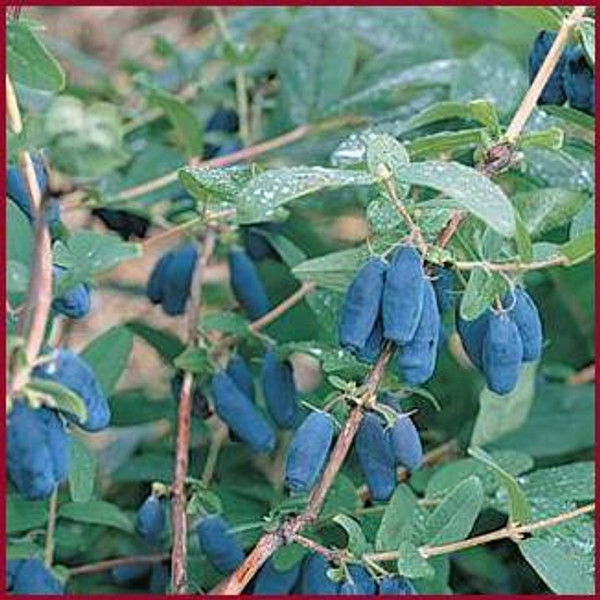Product Overview
Blue Hokkaido
Lonicera caerulea emphllocayx (haskap)
A very popular variety with Japanese Honeyberry growers, Blue Hokkaido features an upright 4-5 ft. tall growth habit and very large, sweet-tart, crisp and flavorful, dark blue berries.
The Fruit:
Honeyberries produce deep blue berries beginning with the strawberry season in late June, and early varieties may produce the first fruits of the year. Later varieties begin a few weeks later, while the latest pickings may be into late August. Fruit may be oblong, barrel, or flattened bullet in shape and contain high levels of antioxidants and vitamin C. As Bob Bors describes the flavor… “it could be described as sweet, sour, bland or bitter versions of raspberry, blueberry, plum or black currents and any mixture in-between. The best ones however seem to have a predominantly raspberry flavor with sweetness and just a hint of sour or bitter or astringency to give a little zing. That little zing might be described as desirable ‘mouthfeel’ in the world of red wine tasting”. Seeds tend to be small and unnoticeable. Honeyberries can be used as a fresh ‘dessert fruit’, as fresh fruit toppings, or in sauces, in pies, jams, compotes, frozen as with other berries, dried as with cranberries, cherries, grapes, or apples, or made into wines.
The Harvest:
The fruits of honeyberry are picked after they turn a deep purple- blue. Sweetness increases with maturity. The berries don’t tend to prematurely drop, and picking too early can result in a sour or bitter taste. Fruit should be blue inside when ripe, not green. Berries can be hand-picked, shaken from the plant, or machine-harvested. Plants begin to yield in 1-2 years after planting
Planting considerations:
Honeyberries grow in blue-berry type soils, being a fibrous and shallow-rooted plant. Soil PH should be within the 5-7 range. Plants can take heavy soils, as they are from wetland or marginal ancestry, however planting in sunny, well-drained organic soils should bring more dependable performance. When planting in rows, a 3-4 ft. x 10 foot spacing between rows seems to be the general recommendation. Even watering is quite important, although Russian publications suggest that established plants are mildly drought-tolerant. Honeyberries are hardy to USDA Zone 2; blossoms in spring are also very hardy and can survive temperatures of 22-24 degrees. Pollination Requirements: Although many varieties may be considered self-pollinating and will set some fruit, it is generally considered more productive to have 2 or more varieties from the same blossoming season (ie: ‘early flowering, or late…’) to provide cross-pollination.







